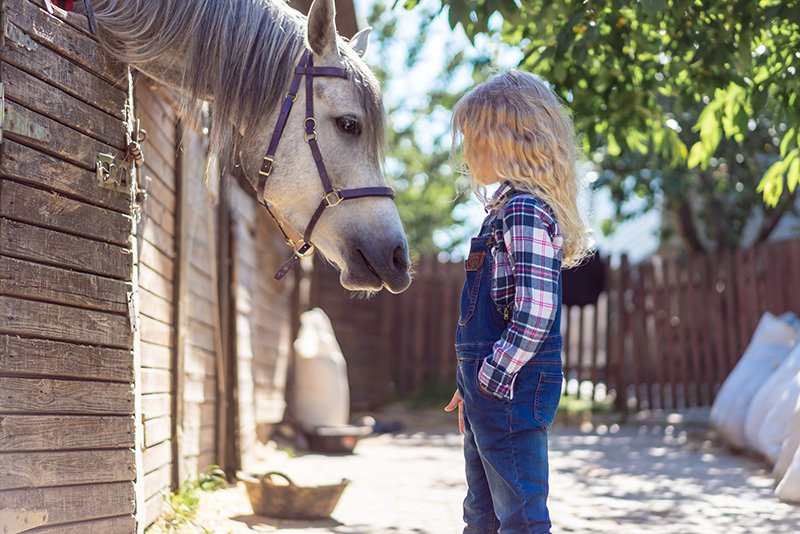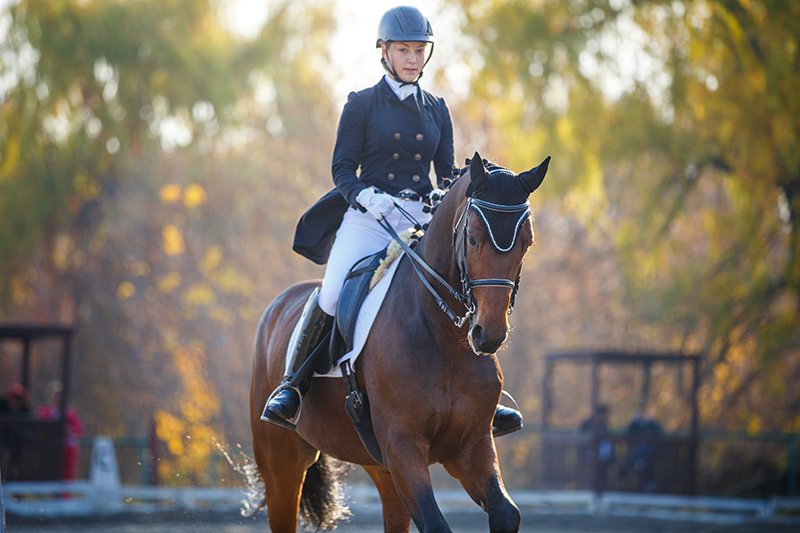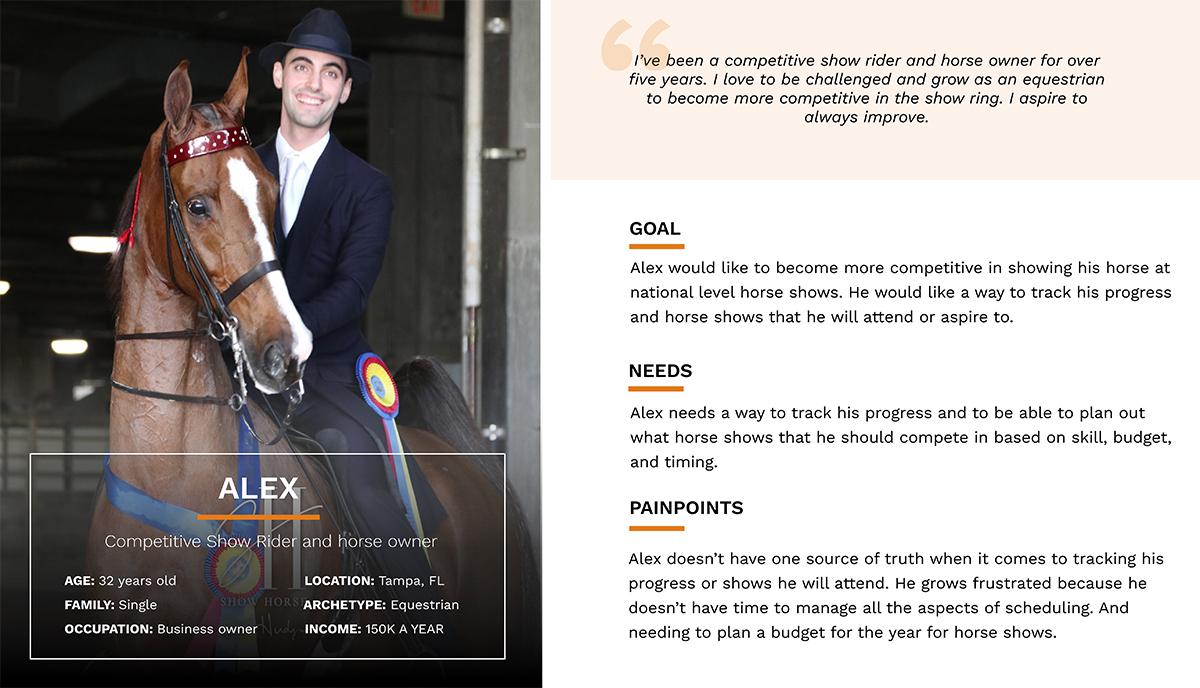Capstone Project
MICA UXD Master’s Program Case Study
My Roles
Lead Designer, Researcher, Project Manager, and Product Owner
Timeline
7 Weeks (10/26/2023 – 12/14/2023)
Tools Used
Figma, Illustrator, Photoshop, User Brain, Google Forms, Google Slides, Miro, MindMeister
The Problem Statements
Identifying
The Challenge
The challenge today for newcomers to equine activities is those coming into the sport without any equine knowledge. The cognitive load is overwhelming, and most horse stables do not utilize technology to streamline their business.
As an established equestrians, they are mainly used to the manual methods they have grown accustomed to. Such as utilizing manual methods like a paper calendar, paper sign-up forms for activities, paper release forms, checks for payments, and forms of communication by phone or text. There is limited online presence.
The equine industry is slowly adapting to technology and some just don’t feel comfortable or understand how to use more advanced methods online. Today, there are limited technical resources and platforms that meet the needs to consider in adopting.
Early Insights
The Opportunity
The opportunity to improve customer growth and sustain existing customers by improving how equestrians schedule and pay for lessons and track their riding progress by setting goals. I believe there is a way to sign up for lessons effectively and efficiently and improve the experience for all levels and aged equestrians.
The Mission
Protect, preserve, and grow equestrian sports and activities for future generations by empowering all equestrians to reach their potential.
The Strategy
Research
User Interviews and Surveys
Recruited various participants ranging from equestrians to non-equestrians, riding instructors, barn owners, and horse trainers.
Competitor Analysis
Analyzed a variety of eight direct and indirect competitors.
Desk Research
Researched problem or design challenges by reviewing existing knowledge and info to inform pain points, context, and scope.
.
Personas
There is an ‘equestrian’ user type with two personas: new and existing customers.
.
Journey Map
Focused on understanding the persona’s feelings and thinking about their current and future experiences and how they can be improved upon.
.
Key Findings
Based on the research and data, there is a clear path into these 5 key findings to serve as opportunities.
An App is Preferred
Participants wish there were an app to schedule and pay for lessons, track progress or volunteer hours, manage horse management, trainers schedule payment plans and show schedules.
Mix of age & Rider Level
50% of participants were beginner riders and 12 years or younger, the other 50% were show riders and 36 years or older.
Nearly 75% of the participants owned their own horse and rode at least twice a week or more.
Trials and Tribulations
The majority of riders found their barn my trials and frustrations, while some found their riding facilities through word of mouth or their parents signed them up for lessons.
Some mentioned it would be helpful to see reviews and ratings of barns.
App Feature Mentions
Participants feature request of an app were the following.
- Schedule and Pay for Lessons (100%)
- Show Schedule and memberships (75%)
- Progress tracking and goals (100%)
- Horse Wellness (60%)
- Billing (100%)
- Communication (80%)
- Weather (29%)
- Educational Articles (60%)
Mentioned Concerns
The majority said that safety and ethics were the top of mind for concerns. On a different note, some said that some may not be technical savvy for an app, and that having an app may lose the personal touch that they have with the manual methods.
Personas and Journey Mapping
An ‘Equestrian’ is the user type of two personas, which are the ‘New to Equine Activities’ and ‘Established Equestrian’. Below you see the gaps identified and friction in the experience for their journey, and how Stable Solutions will reduce these.
Meet Elizabeth, New to Equine Activities
Elizabeth is a mother of two children and works part-time. Her daughter is interested in getting involved in equine activities. Neither knows anything about horses, so this process is foreign. Unlike her son’s soccer activities, she is rather involved, and his schedule, activities, and payments are all done seamlessly online.
Elizabeth needs an easy and effective way to sign her daughter up for riding lessons online, and that is a way to give her the tools to understand how her daughter is succeeding and progressing in her riding activities. The pain point she is currently facing with signing her daughter up for riding lessons is that it lacks efficiency, effectiveness, and resources compared to what she is used to with her son’s activities.
Meet Alex, An Established Equestrian
Alex has been a competitive rider for over five years and competes locally and nationally. He is a young professional who owns his marketing firm and has limited time to spare. He would like to become more competitive in showing his horse, but he would like to track his progress and horse shows that he will attend or have.
Alex’s main pain point is that he doesn’t have one source of truth regarding monitoring his progress. He grows frustrated because he doesn’t have the time to manage all the aspects of the lesson, show schedule and travel, and how to budget financiall
The Strategy
Design
Wireframes
Helped with the interface, information architecture, and flow prior to higher fidelity.
Low-to-high Fidelity
Iterated on the designs from low-to-high fidelity before an interactive prototype. Design System was created at this time.
Prototype
An interactive prototype was created in Figma and local components.
User Testing
Utilized User Brain for unmoderated user testing and also 1:1 usability testing sessions.
.
Design Iterations
Taking the user testing feedback making iterations, and prioritizing additional launch plans.
.
Usability Testing
User Brain recruited six participants for an unmoderated usability test. Design iterations will be made based on the feedback.
Micro Interactions
Many participants found the quiz and visuals beneficial, but some mention they would like less interactions and additional text.
Payment Flow
Some were expecting a deposit to be made in order to confirm their scheduled lesson.
Filters
There was confusion around the riding categories under search and the filters.
Usability Testing Feedback
Appealing and Clear
I like the pictures, though. They showed me instead of describe because if I’m a beginner, I’m not gonna know what I’m looking for if you give me a bunch of words. So the pictures were helpful.
Intuitive
I like how there’s a little progress bar at the bottom there. I always like to know where I am in the process and roughly how long it’s gonna take me.
Quick and Effective
I was appreciative of how the booking process was quicker than I expected.
Next Steps
I will continue to iterate on the prototype and introduce additional features to be further tested. I have an opportunity in 2024 to showcase my idea during an Equine Conference to bring it more to life.
Reflections
Ambiguity
Based on my original timeline, I had some setbacks and had to pivot on deliverables and their due dates. I was able to reevaluate priorities and establish a new timeline that was met.
Flexibility vs. Usability
Based on the research data, there are many features that would benefit the user, but I had to scope the product features in phases. Through the research, there were also other personas that I found that had similar but different needs from a business perspective. This was well beyond the scope of the first phase. The additional personas would be barn owners, trainers, and riding instructors.
Below is the breakdown of the additional phases and features that I would like to introduce to the product.













